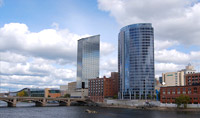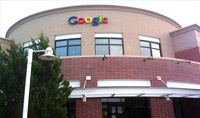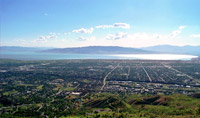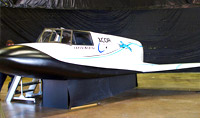Leading Locations for 2015 Resources
Most community leaders would agree that what is most important for economic sustainability is not a one-time, lucky swing at the plate that brings in a big company, but a holistic strategy of economic development with well-thought-out goals. Community and business leaders then collaborate to make the necessary investments to achieve those goals five, 10, or 15 years down the road.
The benefits of this mindset go far beyond the bottom line. When cities invest in themselves to create a strong workforce and a prosperous, conscientious business community, they create a place with a high quality of life. This leads to in-migration of talented people with multiple skills and talents. Successful companies will attract suppliers and other business investment — possibly even creating clusters or corridors that gain national attention. All these things increase the leverage a community has for attracting new business, as well as its ability to offer compelling incentives to top-level companies — creating a track record of economic success.
Included in the Leading Locations report on AreaDevelopment.com is an interactive table that will allow viewers to sort the rankings of all 373 MSAs included in this year’s study. The report includes an overall ranking that is based on 21 economic indicators. Area Development also created category rankings that are based on sub-groups of indicators from the 21 used for the overall results (refer to the methodology to learn more). Readers can use filters to easily segment MSAs by region, population size, and state, or use the search field to locate specific MSAs. The expanded version of the chart displays how each city ranks in every one of the 21 indicators used in the study.
Area Development’s research desk compiled the statistics for this report. Locations were ranked according to the methodology explained herein. Location profiles/articles researched and written by Mark Crawford, Staff Editor.
The Denver-Aurora-Broomfield Metropolitan Statistical Area (MSA) in Colorado has a current population of almost 2.7 million. As of January 2015, the unemployment rate in Denver was 4.6 percent, a reflection of the 46,200 jobs the city added in 2014. An additional 45,000 jobs are expected to be created in 2015, representing a 3 percent growth rate.
All three cities have similar diverse economies, including advanced manufacturing and other high-tech industries like aerospace, telecommunications, biotechnology, and clean energy. The Solar Technology Acceleration Center in Aurora is the largest test facility for solar technologies in the U.S. In fact, metropolitan Denver and the Northern Colorado corridor combined rank sixth in the country for clean-energy employment.
Denver is also emerging as a financial services center. WorldRemit, a London-based financial services firm, recently announced it would open a North American headquarters and operations center in Denver. “Denver offers the perfect combination of a highly skilled workforce, supportive local authority, and idyllic location,” says WorldRemit CEO Ismail Ahmed. “The city is gaining a reputation as a go-to destination for the burgeoning financial-tech sector and stealing the thunder of New York and Silicon Valley.”
Houston-Sugar Land-Baytown represents a current population of nearly 6.4 million people and shows steady population growth. Net migration in 2013 was 17,210 people. One reason for this in-migration is that the Houston area is a good place to find a job. Metro Houston created 120,600 jobs in 2014, a 4.2 percent increase over the previous year, according to the U.S. Bureau of Labor Statistics — placing Houston third in the country for job creation.
Key industries for job growth in the Houston-Sugar Land-Baytown MSA are energy, education, healthcare, professional and business services, transportation, utilities, construction, mining, and logging. Sugar Land continues to see big investments from a diverse range of industries. In 2014 the city announced projects totaling $89 million in capital investment that will create 2,304 new jobs. Top players in Sugar Land are Minute Maid, United Healthcare, Texas Instruments, Schlumberger, and Fluor Corporation.
Petroleum and chemicals are especially important to the Baytown economy. In 2014 ExxonMobil Chemical Company announced it would build a multibillion-dollar ethane cracker in Baytown to provide ethylene feedstock for downstream chemical processing. It has committed $1 million to the Community College Petrochemical Initiative, a training program offered by nine Houston-area community colleges, to help create its future workforce.
Total employment in the Grand Rapids-Wyoming MSA is projected to grow 3.2 percent in 2015, according to the W.E. Upjohn Institute for Employment Research. Total unemployment in the region has fallen to about 4.6 percent — a result of a resurgence in manufacturing, construction, and retail.
In October 2014 Forbes.com ranked Grand Rapids-Wyoming fifth-best in the country for regional economic growth on a per capita basis from 2010 through 2013, based on a study by the Bureau of Economic Analysis. At 7.8 percent, Grand Rapids’ per capita gross domestic product (GDP) growth rate (2010–2013) more than doubled the national growth rate of 3.8 percent.
Key industries are advanced manufacturing, life sciences, agribusiness, aerospace and defense, and information technology. With these productive science-based sectors, it is not surprising that Grand Rapids-Wyoming ranks 13 for science and engineering occupations as a percentage of total workforce.
In 2014 Grand Rapids-Wyoming announced 22 projects totaling $315 million capital investment, creating 2,183 jobs. For example, Chinese auto supplier Dicastal North America decided to establish its first U.S. facility in nearby Greenville. The $140 million plant will hire 300 workers over the next four years to manufacture aluminum-alloy wheels. The company explored 35 sites in seven states before making its final decision.
Mid-Size Cities (Population 160,000-600,000)
Greeley is the second-largest city in northern Colorado and operates as a major retail trade center for agricultural producers in Wyoming, Nebraska, and Colorado. The market value of agricultural products for Greeley and surrounding Weld County is about $1.5 billion annually.
Greeley is also in the heart of Colorado oil country — its second key industry. Food processing, construction, and retail are also on the rise. Major companies are State Farm, Noble Energy, and JB USA — the biggest producer of meat protein in the world. According to statistics cited in the June 2014 “U.S. Metro Economies” by the U.S. Conference of Mayors, Greeley was ranked as one of the leading cities for future economic growth — about 4.8 percent — almost twice that of the U.S.
Investment continues in agriculture and energy. Leprino Foods, a producer of mozzarella cheese, is constructing an 800,000-square-foot plant that will employ 500 people. The company’s milk needs will boost the local dairy herd population by 60,000 animals. When it comes to energy, Weld County has more oil and gas well permits than any other county in Colorado. The wide-open plains around Greeley are ideal for generating wind energy. To keep up with increased demand for wind turbines, local turbine manufacturer Vestas is hiring 400 new workers to expand production at its Windsor facility, just a few miles from Greeley.
With nearly 300,000 residents, Boulder packs a powerful economic punch. Key sectors are aerospace, bioscience, clean tech, information technology, and software. With the University of Colorado-Boulder, a top research university, and 17 federally funded research laboratories, Boulder has a reputation for innovation and scientific leadership. Leading companies in Boulder that draw from the ranks of skilled graduating students include Google, IBM, Ball Aerospace, Lockheed Martin, Medtronic/Covidien, and Micro Motion.
As a result, Boulder is home to one of the most highly educated and entrepreneurial populations in the country. A February 2015 study by NerdWallet showed that Boulder had the highest density of startups among the cities it studied.
According to the PricewaterhouseCoopers/ National Venture Capital Association (NVCA) MoneyTree Report™, over the past five years more than $850 million has been invested in Boulder companies, representing more than one quarter of the total venture capital investment in Colorado firms. And so far that momentum has carried over into 2015 — five of the 23 venture capital deals in Colorado during the first quarter of 2015 involve Boulder companies, totaling $28 million.
The Provo-Orem MSA has a population of more than 500,000 people and one of the youngest workforces in the country. It also has an enviably low unemployment rate of about 3 percent. Provo is home to Brigham Young University — one of the country’s top universities for spinning off start-up companies from innovative university research.
Therefore, it is not surprising that Provo-Orem has an outstanding high-tech reputation. A number of global IT companies, including Novell, WordPerfect, and PowerQuest, originated in Provo-Orem. Provo was listed as the second-best performing city in the U.S. in 2013 by the Milken Institute and was ranked a top city for IT job growth by NewGeography.com in 2014. Skilled scientists and engineers graduate into the MSA’s workforce every year from Brigham Young University and Utah Valley University.
The Associated Press recently ranked Provo-Orem eighth in the nation for venture money invested in tech startups during the first nine months of 2014. However, Provo-Orem scored first for average dollars per deal — $51.3 million, almost three times more than the number-two city (San Francisco) at $18.4 million per deal.
Small Cities (Population < 160,000)
Columbus recently experienced its fifth straight year of economic growth in 2014. Nominal GDP, employment, labor force, and income continue to improve. Job growth in 2014 was 4.1 percent, placing Columbus 14th out of 363 MSAs in the U.S.
The Columbus economy is driven by manufacturing — in fact, nearly 40 percent of the local employment is manufacturing-related. Automotive is the key industry. Cummins, Enkei, PMG, Faurecia, and other automotive-related firms operate in the area, including top tier-1 and tier-2 suppliers. To support other advanced manufacturing industries, the Advanced Manufacturing Center of Excellence, a 43,000-square-foot facility shared by several local universities and colleges, opened in 2012. The center aims to facilitate collaboration between industry and academia to develop training in topics such as materials and heat treatment, mechanical engineering/mechatronics, and robotics.
As a result of this proactive support, manufacturers continue to invest in Columbus. For example, Sunright America, North America’s largest manufacturer of metal fasteners, recently completed a $34.6 million expansion. In another expansion move, Impact Forge Group, a manufacturer of critical safety-forged components for the automotive industry, will spend $7.5 million to expand its 138,000-square-foot Columbus production center.
In 2013 the Milken Institute ranked Midland the fifth-best-performing small city in the U.S., with top-place finishes for five-year job growth and wages and salaries growth. In its “U.S. Metro Economies GMP and Employment Report for 2014,” the U.S. Conference of Mayors ranked Midland first for projected annual growth by 2020 — a whopping 7 percent. Currently the unemployment rate is about 3.7 percent.
Midland’s dominant industry is oil and gas, which is experiencing a significant slowdown — Midland lost 300 oil jobs from February to March 2015. However, strong performances by manufacturing, hospitality, and other business services sectors helped offset these losses — from March 2014 to March 2015, Midland added 7,100 new jobs.
Midland continues to diversify its economy with the addition of aerospace. The Midland airport received a spaceport license in September 2014 and is now officially the Midland International Air and Space Port. Tenants include XCOR Aerospace and Orbital Outfitters, a space suit manufacturing company. In October 2014, Orbital Outfitters started construction on its new test, manufacturing, and headquarters facility.
“We couldn’t have gotten here without the support of the Midland community and city leaders,” says Jeff Feige, CEO of Orbital Outfitters. “The city of Midland has welcomed us with open arms, and we just can’t wait to get this facility up and running.”
Located in the heart of the Permian Basin in Texas, Odessa is a long-established center of oil and gas activity, with a well-established network of producers and suppliers. The current drop in energy prices has slowed production and caused slight attrition of the workforce. Other top employers in the city are Saulsbury Industries (electrical/construction), Odessa Regional Medical Center, and Investment Corporation of America (financial).
Odessa has enjoyed continuous economic growth from 2010 to 2015. Over that five-year time period, the Odessa Economic Index (OEI) has expanded by 67 percent, averaging more than 13 percent per year, resulting in about 23,000 new jobs. Even with the current low oil prices, the March 2015 OEI is still 7.5 percent higher than it was a year ago.
The analysts behind the Odessa Economic Index believe that oil prices will almost certainly recover and again drive the Odessa economy. In the meantime, both consumer activity and outside income remained strong in 2014, especially hotel-motel tax collections. The housing and construction markets are also fairly steady. Other key economic sectors for Odessa are logistics and distribution and manufacturing. The city continues to upgrade and expand its industrial park and invest in workforce training programs. Odessa is also exploring ways to diversify its economy, including bringing in more advanced manufacturing companies, as well as clean-energy projects that include wind, clean coal, and nuclear energy.









